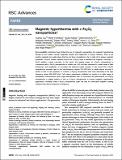Por favor, use este identificador para citar o enlazar a este item:
http://hdl.handle.net/10261/227137COMPARTIR / EXPORTAR:
 SHARE SHARE
 CORE
BASE CORE
BASE
|
|
| Visualizar otros formatos: MARC | Dublin Core | RDF | ORE | MODS | METS | DIDL | DATACITE | |

| Título: | Magnetic hyperthermia with ε-Fe2O3 nanoparticles |
Autor: | Gu, Yuanyu CSIC; Yoshikiyo, Marie; Namai, Asuka; Bonvin, Debora; Martínez, Abelardo; Piñol, Rafael CSIC ORCID; Téllez, Pedro; Silva, Nuno Joâo O.; Ahrentorp, Fredrik; Johansson, Christer; Marco-Brualla, Joaquín; Moreno-Loshuertos, Raquel; Fernández-Silva, Patricio; Cui, Yuwen; Ohkoshi, Shin-ichi; Millán, Ángel CSIC ORCID | Fecha de publicación: | 2020 | Editor: | Royal Society of Chemistry (UK) | Citación: | RSC Advances 10(48): 28786-28797 (2020) | Resumen: | Biocompatibility restrictions have limited the use of magnetic nanoparticles for magnetic hyperthermia therapy to iron oxides, namely magnetite (Fe3O4) and maghemite (γ-Fe2O3). However, there is yet another magnetic iron oxide phase that has not been considered so far, in spite of its unique magnetic properties: ε-Fe2O3. Indeed, whereas Fe3O4 and γ-Fe2O3 have a relatively low magnetic coercivity, ε-Fe2O3 exhibits a giant coercivity. In this report, the heating power of ε-Fe2O3 nanoparticles in comparison with γ-Fe2O3 nanoparticles of similar size (∼20 nm) was measured in a wide range of field frequencies and amplitudes, in uncoated and polymer-coated samples. It was found that ε-Fe2O3 nanoparticles primarily heat in the low-frequency regime (20–100 kHz) in media whose viscosity is similar to that of cell cytoplasm. In contrast, γ-Fe2O3 nanoparticles heat more effectively in the high frequency range (400–900 kHz). Cell culture experiments exhibited no toxicity in a wide range of nanoparticle concentrations and a high internalization rate. In conclusion, the performance of ε-Fe2O3 nanoparticles is slightly inferior to that of γ-Fe2O3 nanoparticles in human magnetic hyperthermia applications. However, these ε-Fe2O3 nanoparticles open the way for switchable magnetic heating owing to their distinct response to frequency. | Versión del editor: | https://doi.org/10.1039/D0RA04361C | URI: | http://hdl.handle.net/10261/227137 | DOI: | 10.1039/D0RA04361C | E-ISSN: | 2046-2069 |
| Aparece en las colecciones: | (ICMA) Artículos |
Ficheros en este ítem:
| Fichero | Descripción | Tamaño | Formato | |
|---|---|---|---|---|
| magnanop.pdf | 1,75 MB | Adobe PDF |  Visualizar/Abrir |
CORE Recommender
WEB OF SCIENCETM
Citations
30
checked on 20-feb-2024
Page view(s)
128
checked on 23-abr-2024
Download(s)
120
checked on 23-abr-2024
Google ScholarTM
Check
Altmetric
Altmetric
Este item está licenciado bajo una Licencia Creative Commons

